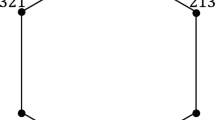Summary
Static DHT topologies influence important features of DHT systems such as their scalability, communication load balancing properties, routing efficiency and their fault tolerance. While obviously dynamic DHT algorithms which have to approximate these topologies for dynamically changing sets of peers play a very important role for DHT networks, important insights can be gained by clearly focussing on the static DHT topology as well. In this paper we analyze and classify current DHTs in terms of their static topologies based on the Cayley graph group-theoretic model and show that most DHT proposals use Cayley graphs as static DHT topologies, thus taking advantage of several important Cayley graph properties such as symmetry, decomposability and optimal fault tolerance. Using these insights, Cayley DHT design can directly leverage algebraic design methods to generate high-performance DHTs adopting Cayley graph based static DHT topologies, extended with suitable dynamic DHT algorithms.
Access this chapter
Tax calculation will be finalised at checkout
Purchases are for personal use only
Preview
Unable to display preview. Download preview PDF.
Similar content being viewed by others
References
K. Aberer, A. Datta, and M. Hauswirth. P-Grid: Dynamics of self-organization in structured P2P systems, chapter 21, “Peer-to-Peer-Systems and Applications”. Springer LNCS, In Press, 2004.
Sheldon B. Akers and Balakrishnan Krishnamurthy. A group-theoretic model for symmetric interconnection networks. IEEE Trans. Comput., 38(4):555–566, 1989.
Brian Alspach. Cayley graphs with optimal fault tolerance. IEEE Trans. Comput., 41(10):1337–1339, 1992.
P. Berthomé, A. Ferreira, and S. Perennes. Optimal information dissemination in star and pancake networks. IEEE Tran. on Parallel and Distrubuted Systems, 7(12), 1996.
F. Boesch and R. Tindell. Circulants and their connectivities. J. Graph Theory, 8(4):487–499, 1984.
F. Boesch and R. Tindell. Connectivity and symmetry in graphs. In Graphs and applications (Boulder, Colo., 1982), Wiley-Intersci. Publ., pages 53–67. Wiley, New York, 1985.
M. Castro, P. Druschel, Y. C. Hu, and A. Rowstron. Exploiting network proximity in distributed hash tables. In International Workshop on Future Directions in Distributed Computing (FuDiCo), Bertinoro, Italy, June 2002.
Stephen J. Curran and Joseph A. Gallian. Hamiltonian cycles and paths in Cayley graphs and digraphs—a survey. Discrete Math., 156(1–3):1–18, 1996.
W. J. Dally. A VLSI Architecture for Concurrent Data Structures. Hingham, MA: Kluwer, 1987.
M. Datar. Butterflies and peer-to-peer networks. In 10th Annual European Symposium, Lecture Notes in Computer Science, Rome, Italy, September 2002. Springer.
K. Gummadi, R. Gummadi, S. Gribble, S. Ratnasamy, S. Shenker, and I. Stoica. The impact of dht routing geometry on resilience and proximity. In ACM Annual Conference of the Special Interest Group on Data Communication (SIGCOMM), Karlsruhe, Germany, August 2003.
M. C. Heydemann and B. Ducourthial. Cayley graphs and interconnection networks. Graph Symmetry, Algebraic Methods and Applications,“NATO ASI C”, 497:167–226, 1997.
W. Mader. Über den Zusammenhang symmetrischer Graphen. Arch. Math. (Basel), 21:331–336, 1970.
W. Mader. Eine Eigenschaft der Atome endlicher Graphen. Arch. Math. (Basel), 22:333–336, 1971.
D. Malkhi, M. Naor, and D. Ratajczak. Viceroy: A scalable and dynamic emulation of the butterfly. In 21st ACM Symposium on Principles of Distributed Computing (PODC 2002), Monterey, California, USA, July 2002.
G. S. Manku. Routing networks for distributed hash tables. In 22nd ACM Symposium on Principles of Distributed Computing (PODC 2003), Boston, USA, July 2003.
W. Nejdl, M. Wolpers, W. Siberski, C. Schmitz, M. Schlosser, I. Brunkhorst, and A. Löser. Super-peer-based routing and clustering strategies for rdf-based peer-to-peer networks. In 12th Intl. World Wide Web Conference, Budapest, Hungary, May 2003.
S. R. Oehring, F. Sarkar, S. K. Das, and D. H. Hohndel. Cayley graph connected cycles: A new class of fixed-degree interconnection networks. In 28th Annual Hawaii International Conference on System Sciences, Hawaii, USA, May 1995.
S. Ratnasamy, P. Francis, M. Handley, R. Karp, and S. Shenker. A scalable content-addressable network. In Annual Conference of the ACM Special Interest Group on Data Communications (ACM SIGCOMM 2001), San Diego, CA, USA, August 2001.
A. Rowstron and P. Druschel. Pastry: Scalable, distributed object location and routing for large-scale peer-to-peer systems. In IFIP/ACM International Conference on Distributed Systems Platforms (Middleware), Heidelberg, Germany, November 2001.
Gert Sabidussi. Vertex-transitive graphs. Monatsh. Math., 68:426–438, 1964.
M. Schlosser, M. Sintek, S. Decker, and W. Nejdl. Hypercup-hypercubes, ontologies and efficient search on p2p networks. In International Workshop on Agents and Peer-to-Peer Computing, Bologna, Italy, July 2002.
H. Shen, C. Xu, and G. Chen. Cycloid: A constant-degree and lookup-efficient p2p overlay network. In International Parallel and Distributed Processing Symposium (IPDPS2004), Santa Fe, New Mexico, April 2004.
I. Stoica, R. Morris, D. Karger, M. F. Kaashoek, and H. Balakrishnan. Chord: A scalable peer-to-peer lookup service for internet applications. In Annual Conference of the ACM Special Interest Group on Data Communications (ACM SIGCOMM 2001), San Diego, CA, USA, August 2001.
Mark E. Watkins. Connectivity of transitive graphs. J. Combinatorial Theory, 8:23–29, 1970.
B. Y. Zhao, L. Huang, J. Stribling, S. C. Rhea, A. D. Joseph, and J. D. Kubiatowicz. Tapestry: A resilient global-scale overlay for service deployment. IEEE Journal on Selected Areas in Communications, 22(1), 2004.
Author information
Authors and Affiliations
Editor information
Editors and Affiliations
Rights and permissions
Copyright information
© 2006 Springer-Verlag Berlin Heidelberg
About this chapter
Cite this chapter
Qu, C., Nejdl, W., Kriesell, M. (2006). Cayley DHTs — A Group-Theoretic Framework for Analyzing DHTs Based on Cayley Graphs. In: Staab, S., Stuckenschmidt, H. (eds) Semantic Web and Peer-to-Peer. Springer, Berlin, Heidelberg. https://doi.org/10.1007/3-540-28347-1_5
Download citation
DOI: https://doi.org/10.1007/3-540-28347-1_5
Publisher Name: Springer, Berlin, Heidelberg
Print ISBN: 978-3-540-28346-1
Online ISBN: 978-3-540-28347-8
eBook Packages: Computer ScienceComputer Science (R0)




